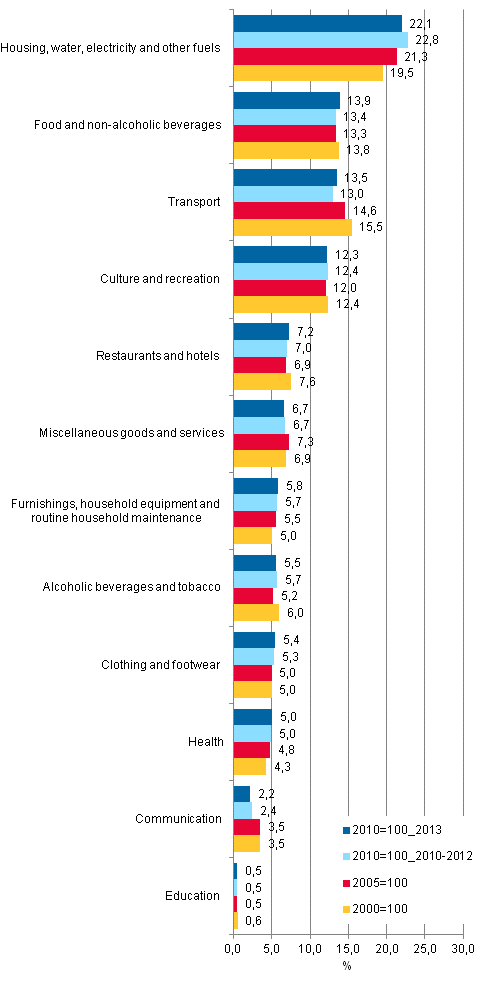News 19.2.2013
Calculation of the Consumer Price Index is revised
Statistics Finland has made revisions to the calculation methods of the Consumer Price Index. In future, the weight structure of the Index is updated annually, which means that the monitored commodities can also be updated annually. In addition, seasonal commodities are included in the calculation during the season when they are sold. The revision is based on adoption of harmonised compilation methods with the Harmonised Index of Consumer Prices. Year 2010 remains as the base year of the Consumer Price Index.
The price development of selected commodities is monitored in the Index. With the help of annually updated commodities and weights, better representation of commodities in the Index is ensured. Previously the weight structure of the Consumer Price Index has been updated in scheduled updates every five years. The previous revision was made at the beginning of 2011, when a larger proportion of commodities were changed. Now, for instance, snacks, dress fabric, and maintenance and repair of entertainment electronics were added as new commodities to the Index. The television license was removed from the Index as it became a direct tax. This revision does not affect the development of the Index.
The Index monitors development in the prices of nearly 500 commodities in all. Every month, around 50,000 items of price data are collected from 2,700 outlets for the Consumer Price Index.
The weight structure of the Index corresponds with consumption in 2012
The weight structure of the Consumer Price Index 2010=100 is based on National Accounts data concerning the year 2011, which have been updated to correspond with the value of private consumption in 2012. In 2012, the value of private consumption was EUR 93.4 billion. In 2010, the value of private consumption of the Consumer Price Index was EUR 83.3 billion, in the base year 2005, the value was EUR 70.4 billion and in 2000 it was EUR 56.5 billion.
Comparison of weight structures of Consumer Price Indices 2010=100 in 2013 and in 2010-2012, 2005=100 and 2000=100, per cent.

The biggest change in the weight structure of the Index from 2010 to 2013 is that the weight share for the housing commodity group has decreased. This means that changes in the prices of the commodities in this group have a smaller impact on the Consumer Price Index than before. Similarly, as the weight shares of food and transport increase, changes in the prices of these commodity groups affect the Consumer Price Index more than before.
The base year of the Harmonised Index of Consumer Prices remained unchanged
Statistics Finland has also revised the Harmonised Index of Consumer Prices calculated for Eurostat, the Statistical Office of the European Communities. Year 2005 remains as the base year of the Harmonised Index of Consumer Prices.
The Harmonised Indices of Consumer Prices are primarily used in price comparisons between the EU countries. The European Central Bank uses the Harmonised Index of Consumer Prices as the measure of inflation in its monetary policy.
The Finnish Harmonised Index of Consumer Prices is mainly based on the same weight and price data as the Finnish national Consumer Price Index, but its commodity selection is narrower. In the Harmonised Index of Consumer Price, the concept of consumption excludes owner-occupancy, games of chance, interests and tax-like payments. The Harmonised Index of Consumer Prices covers under 90 per cent of the national Consumer Price Index.
Inquiries: Mari Ylä-Jarkko +358 9 1734 3310, Johanna Leivo +358 9 1734 3472, Juhani Pekkarinen +358 9 1734 3476
Links:
Release of Consumer Price Index
Review
